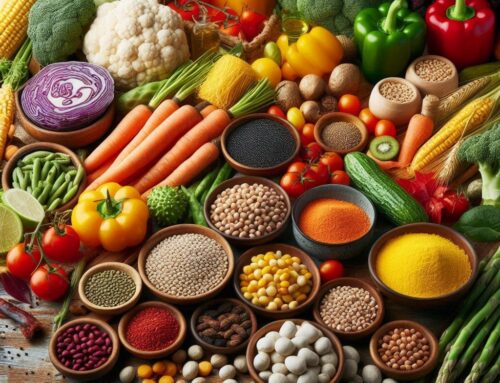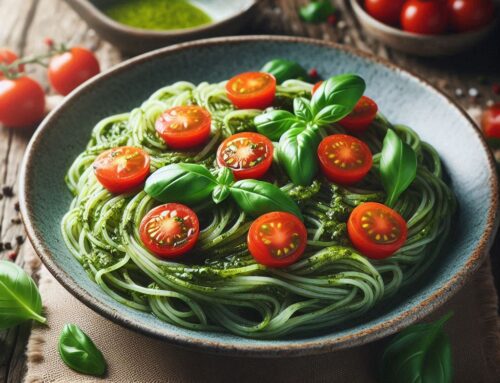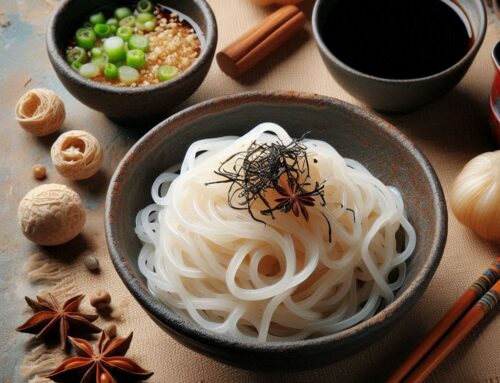
Introduction: What is Konjac Rice and Why It’s Perfect for Low-Carb Diets
Konjac rice, often hailed as a keto-friendly rice, is gaining popularity among those seeking low-carb alternatives. Derived from the konjac plant, this unique rice substitute is composed primarily of glucomannan, a type of soluble fiber known for its numerous health benefits. Unlike traditional rice, konjac rice contains minimal carbohydrates and calories, making it an ideal choice for individuals following low-carb or ketogenic diets.
One of the primary benefits of konjac rice is its ability to aid in weight management. The glucomannan fiber absorbs water and expands in the stomach, promoting a feeling of fullness that can help reduce overall calorie intake. Additionally, this fiber has been linked to improved digestion and better blood sugar control, making it a beneficial addition to any diet focused on maintaining stable energy levels.
For those looking to transition away from conventional grains without sacrificing texture or satisfaction in their meals, konjac rice provides an excellent alternative. Its versatility allows it to be used in various dishes—ranging from stir-fries to soups—offering a seamless way to enjoy favorite recipes while adhering to dietary goals. As more people discover the convenience and health advantages of this innovative product, konjac rice continues to solidify its place as a staple in low-carb eating plans.
The Health Benefits of Choosing Konjac Rice for Your Meals
Konjac rice is rapidly gaining popularity among health enthusiasts, and for good reason. This unique food offers a plethora of health benefits that make it an excellent choice for those seeking nutritious meal options. One of the primary advantages of konjac rice is its low-calorie content, making it an ideal ingredient for those looking to manage their weight without sacrificing satisfaction at mealtime. Unlike traditional rice, konjac rice provides a filling experience with significantly fewer calories, allowing you to enjoy hearty meals without the guilt.
Another significant benefit of incorporating konjac rice into your diet is its status as a gluten-free alternative. For individuals with gluten sensitivities or celiac disease, finding suitable substitutes can be challenging. Konjac rice offers a safe and delicious option that aligns perfectly with gluten-free dietary needs while still providing the texture and versatility needed in various dishes.
Moreover, konjac rice is renowned for its high dietary fiber content. This fiber is primarily glucomannan, which has been shown to support digestive health by promoting regular bowel movements and aiding in maintaining healthy cholesterol levels. The dietary fiber benefits extend beyond digestion; they also contribute to prolonged satiety, helping you feel fuller longer and reducing overall food intake.
Incorporating konjac rice into your meals not only supports weight management but also enhances overall well-being through its impressive nutritional profile. Whether you’re looking to cut calories or find a reliable gluten-free option packed with fiber, konjac rice stands out as a versatile and beneficial addition to any diet plan.
How to Make Delicious Konjac Rice Fried Rice: Step-by-Step Recipe Guide
If you’re looking to enjoy a flavorful and satisfying meal while keeping your carb intake in check, konjac rice fried rice is the perfect dish for you. This keto fried rice recipe not only aligns with low-carb diets but also offers a delightful twist on traditional fried rice. Here’s a step-by-step guide to making this delicious and healthy stir fry.
**Ingredients:**
– 1 pack of konjac rice
– 2 tablespoons of sesame oil
– 1 cup of mixed vegetables (such as bell peppers, carrots, and peas)
– 2 eggs, beaten
– 1 tablespoon of soy sauce or tamari for a gluten-free option
– 2 cloves of garlic, minced
– Salt and pepper to taste
– Optional: cooked chicken, shrimp, or tofu for added protein
**Instructions:**
1. **Prepare the Konjac Rice:** Begin by thoroughly rinsing the konjac rice under cold water. This step helps remove any residual odor from the packaging liquid. Once rinsed, drain well and set aside.
2. **Cook the Eggs:** In a large non-stick skillet or wok over medium heat, add one tablespoon of sesame oil. Pour in the beaten eggs and scramble until fully cooked. Remove from the pan and set aside.
3. **Sauté Vegetables:** In the same skillet, add another tablespoon of sesame oil followed by minced garlic. Sauté until fragrant before adding your choice of mixed vegetables. Stir-fry for about 3-5 minutes until they are tender yet crisp.
4. **Combine Ingredients:** Add the drained konjac rice to the skillet with vegetables along with soy sauce or tamari. Stir everything together well to ensure even coating with flavors.
5. **Add Protein (Optional):** If using chicken, shrimp, or tofu for extra protein content in your meal plan—add them now—stirring occasionally until heated through.
6. **Finish Up:** Return scrambled eggs back into your pan; toss all components gently together ensuring everything is evenly distributed throughout this vibrant low-carb dish!
7. **Season & Serve:** Season according to taste preferences using salt & pepper if needed before serving hot on plates garnished optionally w/spring onions/scallions/chopped cilantro leaves atop each portion presented beautifully ready-to-eat immediately!
This konjac fried rice recipe showcases how easy it can be incorporating low-carb cooking tips into everyday meals without sacrificing flavor satisfaction whatsoever! Enjoy experimenting further within these boundaries exploring new healthy stir fry recipes utilizing versatile ingredients like those mentioned above today itself!
Tasty Variations: Customize Your Konjac Fried Rice with These Ingredients
Konjac fried rice is a versatile and low-carb dish that serves as an excellent base for a variety of culinary creations. By customizing it with different ingredients, you can transform this simple meal into a flavorful and satisfying experience tailored to your dietary preferences. Here are some tasty variations to consider:
For those following keto diets, incorporating vegetable additions can enhance both the nutrition and taste of your konjac fried rice. Consider adding nutrient-rich options like bell peppers, zucchini, or spinach. These vegetables not only add vibrant colors but also provide essential vitamins and minerals without compromising your carb count.
Protein options are another way to elevate your konjac fried rice. Whether you’re looking for plant-based or animal protein sources, there are plenty of choices to suit every palate. For a vegetarian twist, toss in some tofu or tempeh cubes seasoned with soy sauce or sesame oil. If you prefer meat-based proteins, diced chicken breast or shrimp can be quickly sautéed and mixed into the rice for a hearty addition.
Experimenting with these konjac fried rice variations allows you to enjoy a delicious meal while adhering to specific dietary goals. By mixing and matching different vegetables and proteins, you can create endless combinations that keep this dish exciting every time you prepare it.
The Environmental Impact of Incorporating Konjac Products into Your Diet
Incorporating konjac products into your diet is not only beneficial for health but also for the environment. As we strive towards more sustainable food choices, konjac emerges as a standout option due to its minimal environmental footprint. Unlike many agricultural practices that contribute significantly to carbon emissions and deforestation, konjac farming is remarkably environmentally friendly.
Konjac plants require less water compared to other staple crops, reducing the strain on water resources. They are typically grown in mountainous regions where they thrive without the need for intensive irrigation or chemical fertilizers. This natural resilience makes konjac an ideal crop for promoting biodiversity and maintaining soil health.
Moreover, the impact of konjac farming extends beyond just resource efficiency. By choosing konjac-based foods, consumers are supporting agricultural methods that prioritize ecological balance and sustainability. As awareness grows about the importance of environmentally friendly foods, incorporating konjac into our diets can be a simple yet effective step towards reducing our ecological footprint while enjoying versatile and nutritious meals.
Conclusion: Embrace a Healthier Lifestyle with Konjac Rice Fried Rice on Your Menu
Incorporating konjac rice fried rice into your diet can be a transformative step towards embracing a healthier lifestyle. This innovative dish offers a low-calorie, low-carb alternative to traditional fried rice, making it an excellent choice for those looking to manage their weight or maintain balanced blood sugar levels. Konjac rice, derived from the root of the konjac plant, is known for its high fiber content and ability to promote satiety without adding excess calories.
By choosing konjac rice fried rice, you not only enjoy a delicious and satisfying meal but also benefit from the nutritional advantages that come with this unique ingredient. It’s versatile enough to pair with a variety of vegetables and proteins, allowing you to customize your meals while ensuring they remain nutritious and flavorful.
As more people seek ways to improve their dietary habits without sacrificing taste or convenience, konjac rice stands out as an ideal solution. By integrating this dish into your regular meal rotation, you’re taking proactive steps towards better health and wellness. Embrace the change today and experience how this simple addition can make a significant impact on your overall well-being.






